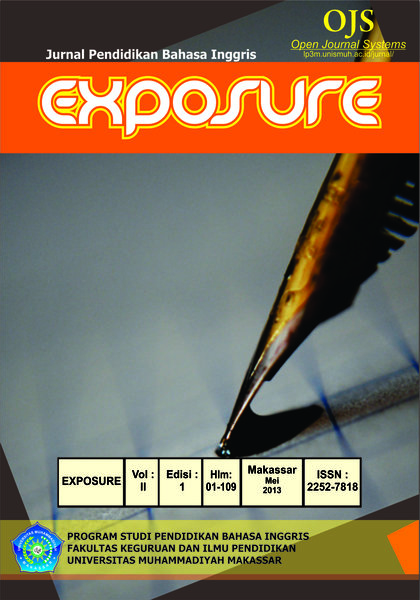THE IMPLEMENTATION OF INFORMATION GAP ACTIVITIES TO IMPROVE STUDENTS’ SPEAKING AND READING SKILLS
DOI:
https://doi.org/10.26618/exposure.v2i1.783Abstrak
This study was conducted to know whether or not the use of Information Gap Activities improves students’ accuracy in speaking skill that covers three elements of accuracy; vocabulary, pronunciation, and grammar; and to know whether or not the use of Information Gap Activities improves students’ literal comprehension in reading skill. This research applied a quasi-experimental design; the nonequivalent control group design. It used two groups; experimental groups and control group. The data obtained from the test was analyzed quantitatively and then its’ result was compared with t-table to know whether they were significantly different or not. The data showed students’ mean score of accuracy in speaking skill and literal comprehension in reading skill improved after teaching by using Information Gap Activities. In experimental class, the students’ accuracy of pretest was 1.55 and improved to be 3.06 in posttest, students’ literal comprehension of protest was 0.82 and posttest was 3.21. In control class, the students’ accuracy was 1.90 for pretest and 2.32 for posttest; students’ literal comprehension was 1.63 for pretest 2.27. These findings indicate that the mean score of pre-test was greater than pretest for that both class. However, the students’ mean score in experimental was greater than control class where accuracy (3.06>2.37) and literal comprehension (3.21>2.27). It meant that implementing Information Gap activities were effective to improve the students’ speaking and reading skills.
Keywords: Speaking and reading skills, accuracy, literal comprehension, Information Gap Activities
Referensi
Aronson, E., N. Blaney, C. Stephin, J. Sikes & M. Snapp. 1978.The Jigsaw Classroom. Beverly Hills, CA: Sage Publishing Company.
----------. 2000. Jigsaw classroom. Online.http://www.jigsaw.org/overview.htm
Bennett B., Rolheiser, C., Stevahn, L. (1991) Cooperative Learning: Where Heart Meets Mind, Educational Connections, Ontario.
Brown, H, D. (2001). Teaching by Principles: An Interactive Approach to Language Pedagogy. New York: Addison Wesley Longman, Inc.
Bio, Bilash. 2009. Improving Second Language Education. Online. http://www2.education.ualberta.ca/staff/olenka.bilash/Best%20of%20Bilash/info%20gap%20activities.html). Retrieved on Monday, June 6, 2010
Bolitho, Rod. 2008. A questioning activity. © British Council, 10 Spring Gardens, London SW1A 2BN, UK© BBC World Service, Bush House, Strand, London WC2B 4PH, UK. Online. http://www.teachingenglish.org.uk/blogs/rod-bolitho/a-questioning-activity
Burn, A., and Joyce, H. 1997. “Focus on Speaking”. National Center for English language teaching and research. Online (http://www.ncltr.mq.edu.Av/Focuspe.Htm). Retrieved on 26th February 2011.
Byk, John. 1999. ESL Lesson Plans About Taking & Giving Directions. http://www.ehow.com/way_5385582_esl-plans-taking-giving-directions.html
Clark and Clark. 1997. Psychology and Language: An Introduction to Psycholinguistics. San Diego: Harcourt Brace Jovanch
Cook, Guy. 1989. Language Teaching: A Scheme for Teacher Education Discourse. Oxford: Oxford University Press
Gay, L. R, et, al. 2006. Education Research, Competencies for Analysis and Application. Eight. Edition. Columbus. Ohio: Charles E, Merril Publishing.
Good, Carter Victor. 1959. The Dictionary of Education; New York: Mc Grow Hill Book Company.
Harmer, J. (1991). The Practice of English Language Teaching. London: Longman Group UK Limited.
Heaton, J.B. 1988. Writing English Language Test. New York: Longman Group UK Limited
Hess, N. (2001). Teaching Large Multilevel Classes. Cambridge: Cambridge University Press.
Unduhan
Diterbitkan
Terbitan
Bagian
Lisensi
Authors who publish with this journal agree to the following terms:
In order to assure the highest standards for published articles, a peer review policy is applied. In pursue of the compliance with academic standards, all parties involved in the publishing process (the authors, the editors and the editorial board and the reviewers) agree to meet the responsibilities stated below in accordance to the Journal publication ethics and malpractice statement.
Duties of Authors:
- The author(s) warrant that the submitted article is an original work, which has not been previously published, and that they have obtained an agreement from any co-author(s) prior to the manuscript’s submission;
- The author(s) should not submit articles describing essentially the same research to more than one journal;
- The authors(s) make certain that the manuscript meets the terms of the Manuscript Submission Guideline regarding appropriate academic citation and that no copyright infringement occurs;
- The authors(s) should inform the editors about any conflict of interests and report any errors they subsequently, discover in their manuscript.
Duties of Editors and the Editorial Board:
- The editors, together with the editorial board, are responsible for deciding upon the publication or rejection of the submitted manuscripts based only on their originality, significance, and relevance to the domains of the journal;
- The editors evaluate the manuscripts compliance with academic criteria, the domains of the journal and the guidelines;
- The editors must at all times respect the confidentiality of any information pertaining to the submitted manuscripts;
- The editors assign the review of each manuscript to two reviewers chosen according to their domains of expertise. The editors must take into account any conflict of interest reported by the authors and the reviewers.
- The editors must ensure that the comments and recommendations of the reviewers are sent to the author(s) in due time and that the manuscripts are returned to the editors, who take the final decision to publish them or not.
Authors are permitted and encouraged to post online a pre-publication manuscript (but not the Publisher’s final formatted PDF version of the Work) in institutional repositories or on their Websites prior to and during the submission process, as it can lead to productive exchanges, as well as earlier and greater citation of published work (see The Effect of Open Access). Any such posting made before acceptance and publication of the Work shall be updated upon publication to include a reference to the Publisher-assigned DOI (Digital Object Identifier) and a link to the online abstract for the final published Work in the Journal.

